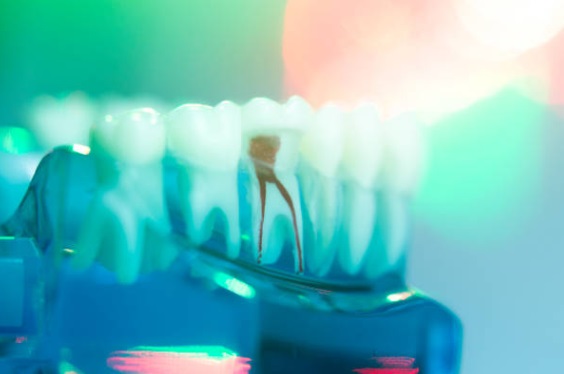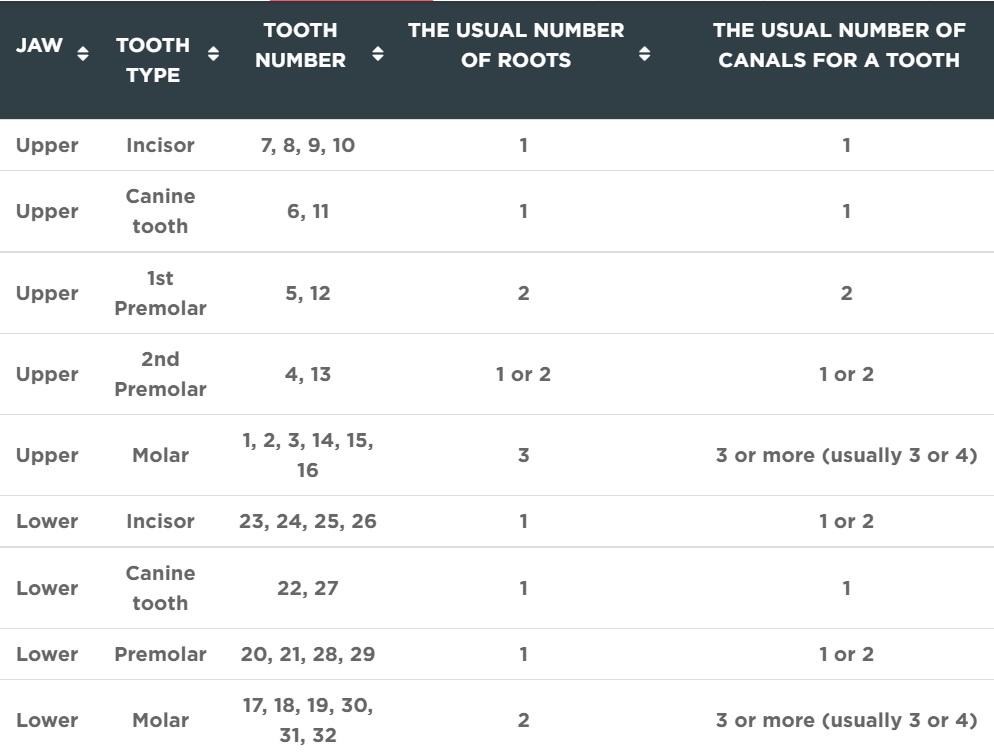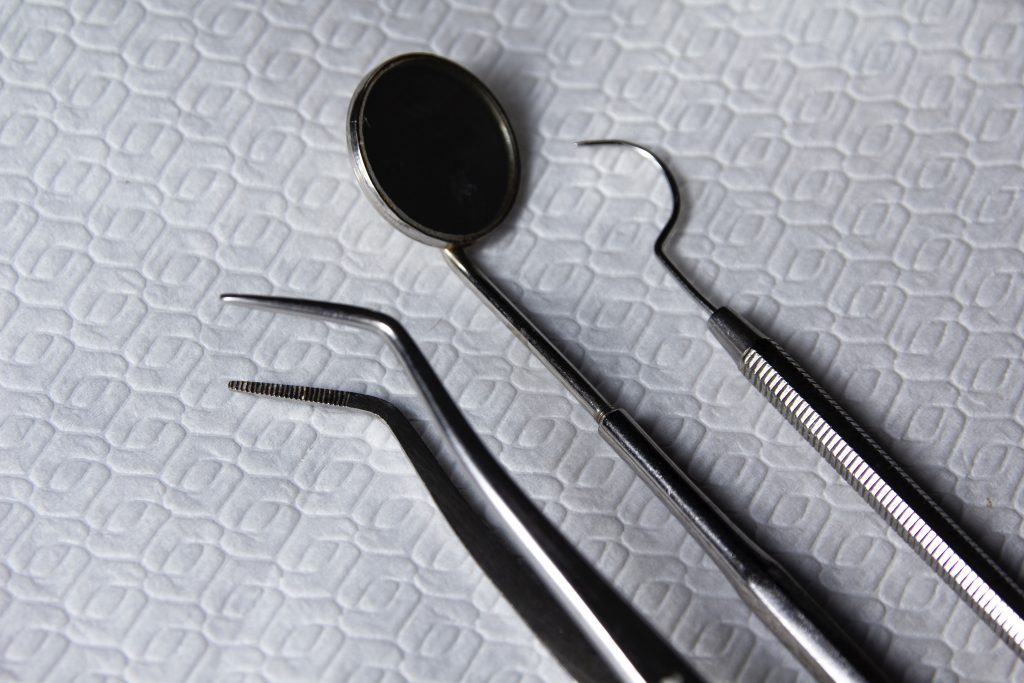
Show the clinics offering Root canal treatment
What is root canal treatment?
All teeth in the jaw have a root canal system in the middle of the tooth (each root). Bacterial infections require root canal treatment. What is a root canal? This treatment is also known as endodontic therapy or endodontic therapy. It allows for the repair and salvation of decayed and infected teeth by removing bacteria from infected root canals. Patients usually visit the dentist when they feel pain in their teeth, but infection is most often the cause of excruciating pain. This can only be corrected by root canal treatment or tooth extraction. Note that regular annual dental visits and good oral hygiene can likely avoid root canal treatment. Nevertheless, the American Endodontic Association estimates that more than 15 million root canal treatments are performed each year.

How many root canals does a tooth have?
The number of canals varies from tooth to tooth. The table below shows the number of roots and root canals for lower and upper teeth.

All front teeth, upper and lower central and lateral incisors, and canines (also called canines or canines) have only one root. In molars, the upper first premolars have two roots, the second premolars have one or two roots, and all the lower premolars have only one root. Upper molars usually have three roots and lower molars usually have two roots. The above rules may vary and your dentist is aware of this and should always be verified before starting treatment. The most important variants are:
- Posterior lower molars usually have at least three roots, but may have as few as two.
- The maxillary second premolar usually has a single root, but may have two root canals.
- It is common for the front upper molars (especially the first molars) to have two canals.
- Central and lateral incisors may have two canals per root.
Because the number of canals is not visible to the naked eye, dentists always perform X-rays or RVGs of infected teeth to see how many canals they actually have. does not guarantee a clear image of the interior of the , and a specialist should perform tomography or microscopy.
The procedure of root canal treatment
Root canal treatment has four stages, and once completed, a severely infected tooth can be put back in place. The duration and number of visits for root canal treatment will vary depending on the type of tooth, condition and number of root canals, but usually one or two visits. Dental x-rays allow the dentist to know the approximate duration of treatment, but the exact number of visits can only be determined after the dentist has opened the tooth and checked the roots. In general, front teeth are treated earlier than back teeth. This is because the canals of the anterior teeth are straight, wide and relatively accessible. Below are the general steps for root canal treatment.
Tooth preparation
Once the dentist has taken the x-rays and has a rough idea of what to expect inside the tooth and how to plan treatment, they administer a local anesthetic that numbs both the tooth and the surrounding tissue. The tooth is then isolated from direct contact with the tooth. Dentists can use a variety of materials and shapes for insulation. However, the British Society of Endodontics recommends the use of rubber dams (called rubber dams) that fit perfectly around the tooth, protecting the inside of the tooth from bacteria in saliva while allowing normal swallowing during treatment. Recommended. It is believed to have greatly contributed to the success of root canal treatment and every dentist should strive to use it. need to do it. A tooth may be so badly damaged that root canal therapy cannot save it and it may need to be extracted.
Tooth opening
When a tooth is paralyzed and isolated, the dentist moves to open it.A so-called “access cavity” (a hole in the tooth) made with a dental drill provides access to the pulp chamber and root system. Make it possible. The dentist should find a narrow, tortuous canal so that any infected material can be seen. Often the tooth must be examined from the inside using a special microscope and very bright light.
Root canal cleaning
After opening the tooth, the dentist thoroughly cleans and disinfects the tooth to remove pulp tissue and contaminants such as debris and bacteria. First, dentists typically measure the length of each root canal using X-rays and electronic equipment. It is important to clean the infected area thoroughly and avoid irritating healthy tissue. Next, clean the canal, widen it, and shape it with some small files (that look like pins). These files break apart and separate tissue and debris from the interior and walls of the tooth. During the tooth cleaning process, the dentist rinses the teeth with an antibacterial solution (such as saline, sodium hypochlorite, citric acid, chlorhexidine) to remove loose debris. This is a very important part and will be done many times during this stage. If the treatment is too complicated to be completed in one visit, the dentist will fill the root of the tooth with a drug that kills any remaining bacteria (called a temporary root canal filling), and will schedule a cleaning and visit. Insert a temporary filler for protection in between. .
Root canal filling
The cleaned, shaped and enlarged canal is prepared for tooth filling. Dentists use gutta-percha material. It is a thermoplastic material that softens when heated and fits perfectly in the chamber. It is very important to fill the entire root canal cavity. Otherwise, the tooth can become re-infected. Once the material has hardened and the root canal has been filled, the root canal treatment is complete, followed by restoration of the visible portion of the tooth. The dentist usually fills the rest of the tooth with a filling material to restore it. Today, dentists recommend using prosthetics such as crowns, denture adhesives, inlays, onlays and overlays to restore teeth after root canal treatment. Of course, the usual fillings are also used, but they are becoming less and less popular.
Crown after root canal treatment
A crown is a cover or tooth cap that replaces a tooth. Restores tooth shape, size, color and function. After root canal treatment, the tooth becomes too brittle to function properly and can crack or break very easily. A crown eliminates these problems. They can be made of ceramic, metal, porcelain, glass powder material, or a mixture of metal and porcelain.
The dentist will take a mold of your tooth to create a mold of your tooth and then start the crown procedure after the root canal treatment. This mold is then used to create a large, perfectly shaped crown. In most cases, it takes several days to make a crown, but some dentists and clinics can make a crown in a day. Once the crown is ready, the crown that will be placed after the root canal is glued to the root inlay.
Recovery after root canal treatment
 A major problem with root canal reconstruction is the delayed relief of root canal pain. Patients often experience severe pain before coming to the dentist’s office, so it’s only natural that they want to get out of there as soon as possible. The anesthesia wears off a few hours after the procedure, and the patient may feel mild pain and tenderness afterwards. However, regular pain relievers (such as ibuprofen or acetaminophen) should help. Symptoms improve in a few days. If not, the patient is advised to visit the dentist to find out what is causing the pain. If the patient decides to put a crown on the treated tooth, a temporary filling is given before the crown is put on, which requires special care. Since such fillings are very fragile, it is not recommended to chew hard, eat sticky food, or apply excessive pressure to the treated tooth. You should take proper care of your teeth. This includes at least he brushing her twice a day, daily flossing, regular professional cleanings at the dentist’s office/dentist’s office, and an annual check-up.
A major problem with root canal reconstruction is the delayed relief of root canal pain. Patients often experience severe pain before coming to the dentist’s office, so it’s only natural that they want to get out of there as soon as possible. The anesthesia wears off a few hours after the procedure, and the patient may feel mild pain and tenderness afterwards. However, regular pain relievers (such as ibuprofen or acetaminophen) should help. Symptoms improve in a few days. If not, the patient is advised to visit the dentist to find out what is causing the pain. If the patient decides to put a crown on the treated tooth, a temporary filling is given before the crown is put on, which requires special care. Since such fillings are very fragile, it is not recommended to chew hard, eat sticky food, or apply excessive pressure to the treated tooth. You should take proper care of your teeth. This includes at least he brushing her twice a day, daily flossing, regular professional cleanings at the dentist’s office/dentist’s office, and an annual check-up.
What is the success rate of root canal treatment?
The success rate and effectiveness of root canal treatment depends on the diagnosis (the state of the pulp just prior to treatment), the anatomy of the root canal system (if the root canal system is very complex, success and effectiveness are much more difficult to achieve). ) and other factors. complicated), proper tooth restoration (the canal may leak if the crown is placed too long), maintenance of oral hygiene, and other general dental conditions (e.g. malocclusion). , misalignment or parafunction).
Root canal therapy belongs to a very successful group of procedures. Nearly 90% of treatments last at least 9-10 years. Of course, patient care and oral hygiene play an important role in the effectiveness and sustainability of treatment. The effects can last a lifetime, especially for non-smokers. Sometimes the treated tooth has a root canal problem and needs a secondary root canal treatment to save it, or your dentist may suggest alternatives such as extraction or a transplant. A professional’s skill and expertise can also affect the effectiveness of a root canal treatment. I am not disrespecting the achievements of regular dentists here, but it is undeniable that an endodontic specialist (certified root canal specialist) performs excellent root canal treatment with minimal failures. If you are looking for specialized treatment, choosing an endodontist is your best bet.
Root canal treatment abroad – How much does root canal treatment cost abroad?
Patients who cannot afford private root canal treatment in the UK and are ineligible for NHS treatment (because there are no such dentists, appointments available too far away, or work required too extensive) have access to medical There is an alternative by Tourism – get medical treatment abroad. The top three countries for medical tourism are Poland, Hungary and Turkey. The advantages of treatment abroad are:
- Significantly reduced prices for all dental care (the difference in cost is due to the low cost of living in these countries)
- High standard of care, modern and well-equipped clinic with dentists speaking fluent English
- Easy access to these countries with cheap direct flights
- Option to book a complete package (treatment, airport pickup, hotel and transport)
- Possibility to combine treatment and vacation

Patients can arrange treatment abroad either directly at the clinic they find or with the help of a medical travel agent. In fact, there are many such institutions that offer clinics in different countries, and their support is free. The advantage of using an agency over booking directly is that the agency works with multiple clinics and can ask all of them for advice and costs to choose the cheapest option for the client. Also, flight bookings, hotels, transportation arrangements, etc. are all organized by the agency, so patients don’t have to worry about anything.
For patients in the UK (also USA, Germany and Scandinavian countries) root canal treatments are most popular in Hungary, Poland and Turkey. Below is a price comparison for several countries.

Typically, the price of root canal treatment in Poland is about 75% cheaper than in the UK. Most clinics are equipped with modern microscopes (laser tooth cleaning) so the entire treatment can be done in just one day. Large cities such as Warsaw, Krakow, Gdansk and Wroclaw are connected by direct flights with several cities in the United Kingdom, Norway, Sweden, Germany and many other European countries, as well as the United States. This means a quick and cheap trip that usually takes only 2-3 hours. Poland is also a beautiful country steeped in history. Patients can have root canals in the Baltic cities of Poland, near the Tatra Mountains, or in other beautiful regions. Regardless of the city, patients can visit interesting places, see history, taste traditional Polish food and relax. Poland is also a very safe country. The political situation is stable, there are no riots or conflicts, and the people are open to tourists (more than 18 million tourists visit Poland annually).

